IJN WW1 submarines
 IJN – About 85 submarines.
IJN – About 85 submarines.
16 different types, and many policy changes: The story of WW1 IJN submersibles
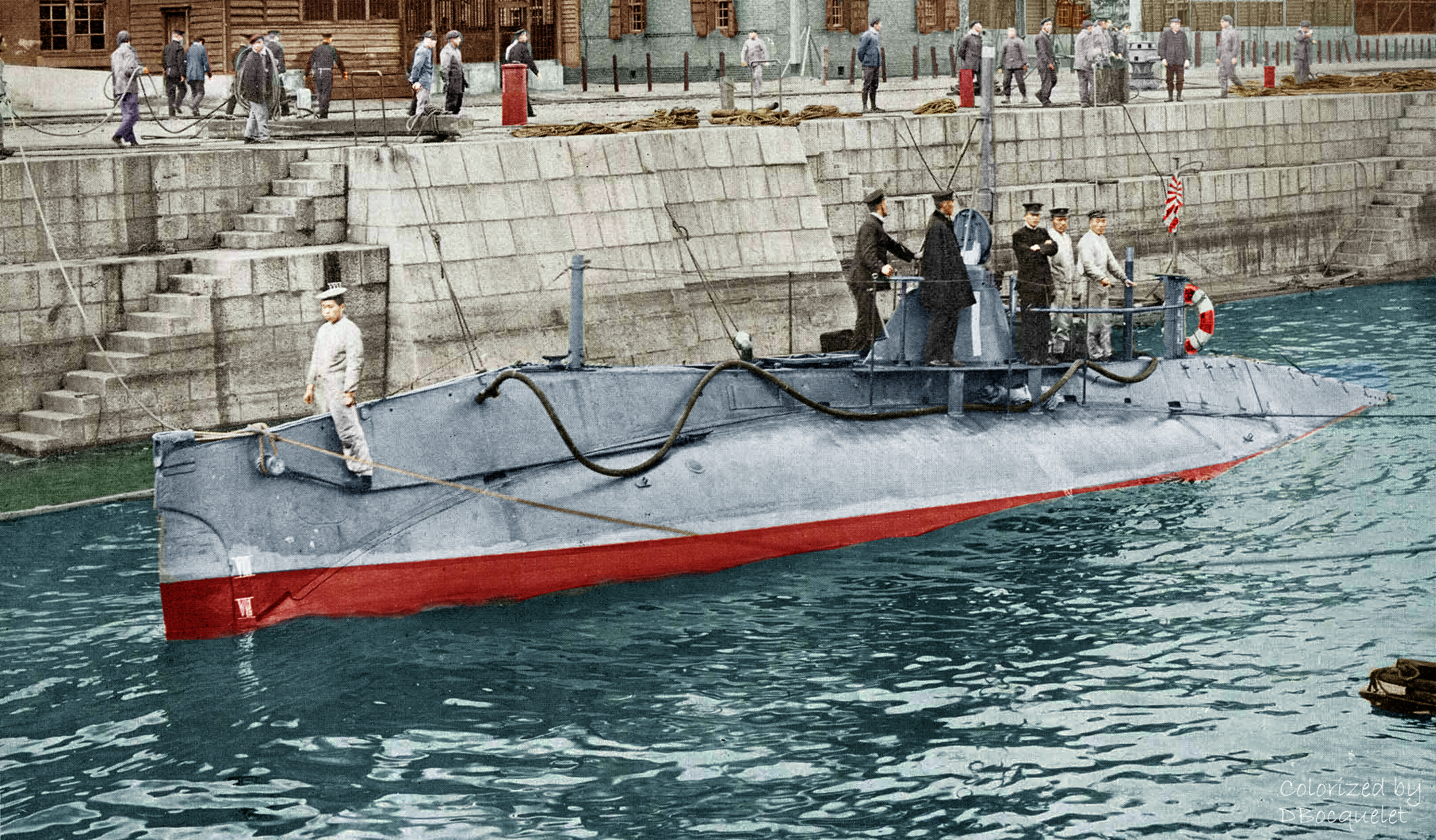
Holland N°1 moving out for a trial in 1908, colorized by the author
A far less well known topic than WW2, the Great War Japanese Submarines is interesting nevertheless to see how Japan started its submarine lineage (“submersible” at that time), logically with the Holland-types and stared quickly its own developments through Mitsubishi, leading to more ambitious oceanic designs in 1919 and the start of a doctrine of long-range warfare as well as the definition of new special types. Indeed, unlike the submarine arms of the western belligerents, IJN submarines saw little action in 1914-18, but observed western developments as well as the battle of the atlantic, which combined with their proper service experience, helped shaping new designs and very important doctrinal changes. #ww1 #IJN #imperialjapanesenavy #submersible #submarine #japanesesubmarine
WWI Imperial Japanese Submarines – A definition
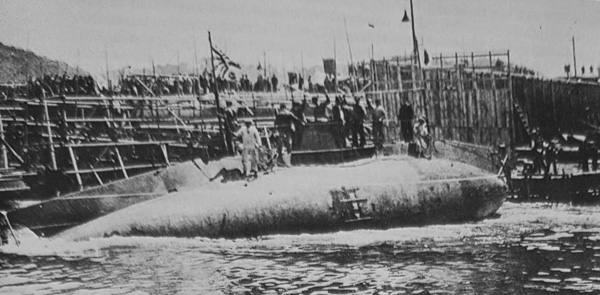
Launch of N°1 Holland Type in the US, for Japan.
The development of IJN submarines was a cautious one. The naval staff, fresh from the alliance with Britain in 1902, saw with interest the testing of the Holland type. Soon the admiralty ordered a few of US-built, British (Vickers) built Hollands but also the French schneider Laubeuf and the Italian Laurenti Types through three naval pogrammes until 1910, in one or two models for each. All these prototypes and the Kawasaki and Mitsubishi built or assembled models brought a lot of practical experience. It’s really from 1919 so after the war with the K types (1917-21) and L types (1919-22) and the final KT types that Japan forged its submersible arm, always “testing waters” of each types produced to only a few boats, at the exception of the K3 type, first largely produced model (10 built) and perhaps the KT type. A doctrinal change in 1922 saw the elmination for good of coastal models and focus on larger ocanic ones. The rest of this history can be seen on the WW2 IJN submarines article.
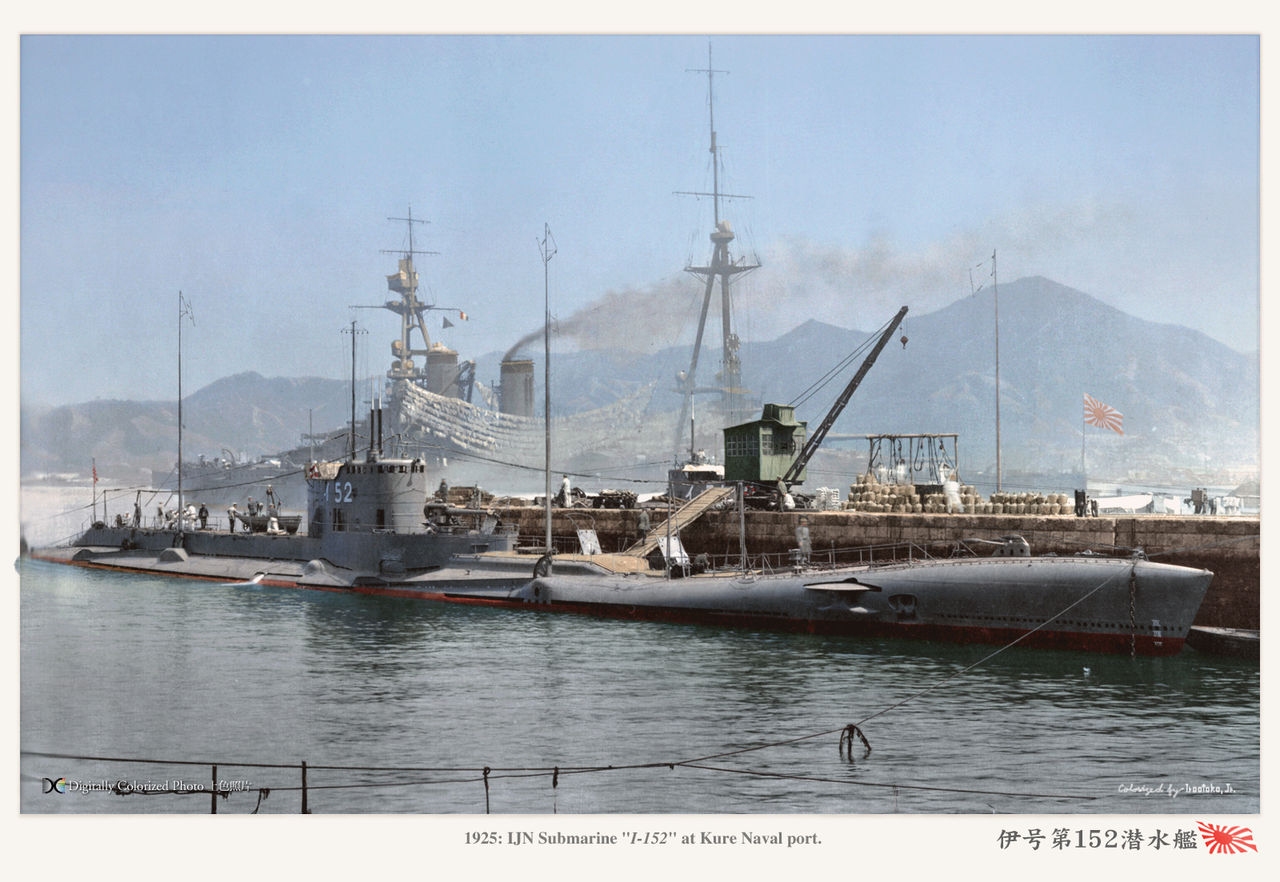
A symbol of the new direction taken in 1922: The large I-125 in 1925, wolorized by irootko Jr. The practice of building a few submarine of each class was carried on in the interwar, with few exceptions.
The 1902 alliance and following Britain
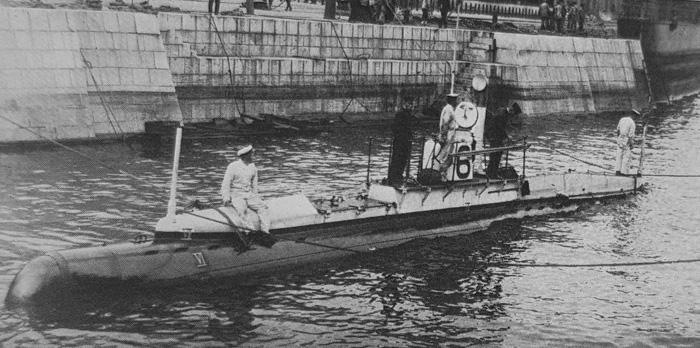
N°6 Vickers Kaigun Type
Japan was not keen at first to jump in the bandwagon of submersible developments as the west, notably because the general staff was more oriented towards a projection of power rather than commerce raiding or defensive warfare. However through its prewar (1902) alliance with the Royal Navy, the general staff was also aware of such enquiries in Great Britain, looking with interest at the US experimentations of Irish inventor John Holland. This traduced by the construction in secret of the “Holland class”. It’s all happened quickly. By January 1900, Washington DC naval attaché Captain Charles Ottley reported on Holland’s progresses and the interest showed by the US government to purchase one. Since 1898 Britain worryngly saw the advances made in submersibles in France, now a potential adversary again after the Fachoda incident.
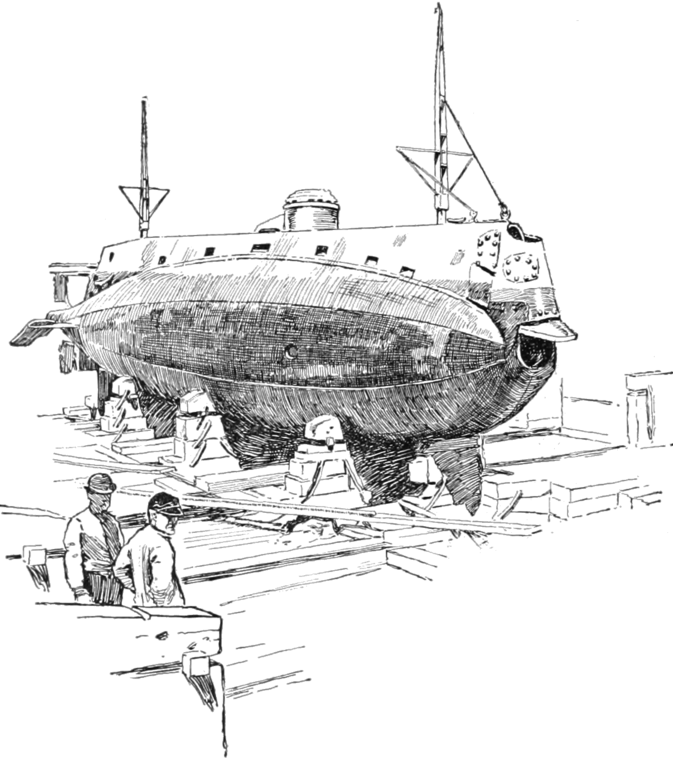
Construction of HMS Holland N°1 in Vickers’s “yacht shed”.
Japan on its side had shifted definitely interest from the French Jeune Ecole after the mixed results at Yalu in 1894 and Bertin’s ideas. Its eyes were turned to the RN as a potential supplier and for training, even before the 1902 alliance, a moved against the always tense relations with Russia, notably about the far east. Back in UK, it’s still in 1900 that Sir John A. Fisher pushed the admiralty to see adoption of a first submarine of the Holland type, to be tested. The news of the USN order started it all.

N°9, C1 Vickers Type in 1911
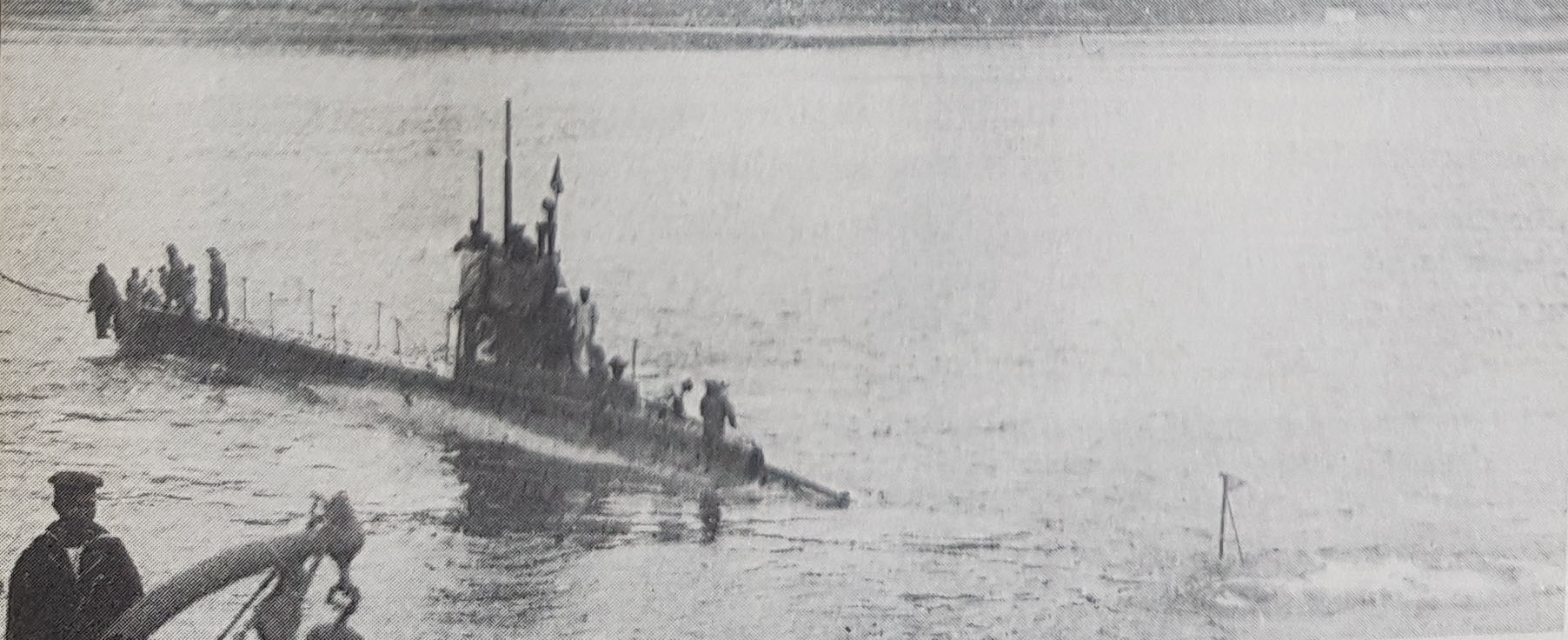
N°12, C2 Vickers Type, 1916
The Admiralty started negotiating with Holland’s Torpedo Boat Co., with Vickers Ltd. intended as trusted local manufacturer, but it’s really the November election which saw the conservative Lord Goschen replaced by more innovation open Earl of Selborne (first sea lord) and young Parliamentary Secretary Hugh Oakley Arnold-Forster, that changed the mood and accelerated the negociations towards a signed contract in December 1900, for a delivery in October 1901.
Construction was made in secret under a “yacht shed”, but the information was nevertheless passed later as the alliance was concluded on 30 January 1902 to the Japanese attaché, which was trusted to keep it. By then, it’s likely the attaché came to see in person the completion of N°1, which started her sea trials by 6 April 1902. Given the fact both the US and Britain went to this new type for experimentation, the IJN naval staff gave the design consideration too.
Nomenclature
WWI numeration (1910-1924)
Submarine classes are distinguished by standard letter-number combinations, eg. C3 for Vickers ‘C’ class Model 3; S 1 – S 2 (Schneider-Laubeuf) for 2 models; F 1 – F 2 (Fiat) Laurenti class (under Kawasaki licence); and L 1 – L 4 Vickers ‘L’ class (Mitsubishi licence) as well as Mitsubishi ‘K’ (for Kobe), K 1 – K 4 and KT whuch were Navy medium classes. KD 1 was a large class based on British practice, KD 2 a large submarine based on the German U 139 which was recently obtained a was compensation.
1924 numeration changes
The submarine numbering system was changed (effective from 1 November 1924) to reflect the new priorities. The smallest boats were classified as “Ha-“, the newly coastal ones as “Ro-“, and the largest were numbered in a new I series. Formerly all submarines had been numbered in a single sequence. The numbers were not sequential but were issued in blocks. Thus the J-type cruisers were assigned I-1 through I-4; the minelayers I-20 series, the KD- type cruisers I-50 series and above. That left the numbers through I-50 blank (but minelayers were later renumbered to remove them from the original sequence), and the result is somewhat confusing: The most modern pre-1941 submarines falling into this series. Early boats were renumbered in 1942, the digit 100 being added to their numbers, to remove them from the lower-numbered parts of the series and make it more sense.
 Holland type (1905)
Holland type (1905)
N°1 to N°6
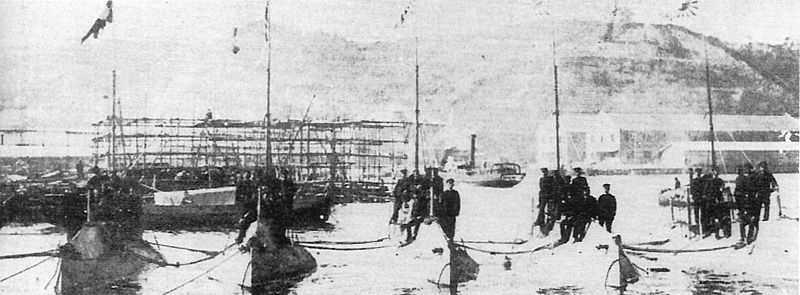
So, later in 1902, a Japanese delegation came to the US and went to Ford River Yard at Holland Company Design to start negociations to acquire their own type of Holland boats. However the same mission wanted still to compare designs, perfectly aware of the advances made in alternative submersibles designs in France and also in UK for a possible licence construction of the British Holland type. Again, like in Britain, utter secrecy was the rule.
Called the “HOLLAND” type submarines these very first Japanese types were ordered from the Fore River Co, Holland company design in 1902 but this was confirmed only after the Japanese naval mission visited Britain and France ending with the United States. They were sent by rail in knocked-down condition to Seattle, North Pacific coast (close to Vancouver) in crates, and from there by ships to Yokosuka, arriving on 12 December 1904. Assembly was delayed and so they were only launched only in March and May 1905, with the first being ready only by June 1905, three years after the British and US Boats. But they also differ from other Holland boats by their greater hull strength reinforced by a broad strip of bronze plating. They also had two bilge keels for better stability, of 24.5ft x 9.5in size (), and a hull further stiffened to resist greater pressure, at a maximum diving depth of 125ft ( meters). Like the British boats, they served their purposes, training a first generation of Japanese submariners and testing initial tactics, and operations. But they were also all stricken much later than the British/US boats: In 1921. No 4 was the only one sunk, at Kure by petrol explosion on 14 November 1916. She was raised and repaired however.
The class comprised the following: No 1 (launched 20.3.05, completed 1.8.05), No 2 (2.5.05, 5.9.05), No 3 16.5.05, 5.9.05), No 4 (27.5.05, 1.10.05), No 5 (13.5.05, 1.10.05).
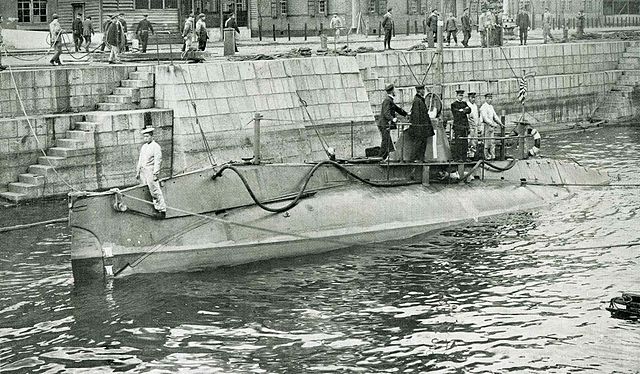
⚙ specifications |
|
| Displacement | 103t/124t |
| Dimensions | 67ft oa, 60ft pp x 11ft 11in × 10ft 3in (20.4m/18.3m x 3.6m x 3.1m) |
| Propulsion | 1 shaft 4-cyl gasoline engine plus electric motor, 180bhp/70hp |
| Speed/Range | 8kts/7kts. Oil 2t. for 184nm/21nm at 8kts/7kts |
| Max depht | 125 ft () |
| Armament | 1-18in (457mm) TT (2 torpedoes) |
| Crew | 13 |
 Kaigun-Holland type (1906)
Kaigun-Holland type (1906)
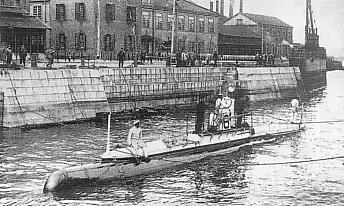
N°6 boat, the lead one of the Kaigun-Holland serie.
These were a landmark, as the first Japanese-built submarines ever. Unlike the first Holland types built in the US based on Japanese specifications, these ones were based on the negociated licence entrusted to Kawasaki Yard in Kobe (hence the “K” in later nomenclature). As they were experimental, only two boats were made, Numbered N°6 and 7.
They were known as the “Kaigun-Holland”, meaning in some way “admiralty-Holland” type, and still heavily borrowing on the Holland design, as the team at Kawaki worked with a detached design team from the US, so directly under Holland supervision.
Alrhough longer, they were much slimmer and thus displaced less, at just 57/63 tonnes versus 103/124 tonnes, almost 50%.
Despite of this, the Japanese wanted to improved the performances in overall speed (which the narrower hull helped greatly), more power, and an even stronger hull for greater dives.
They had for example a 300 hp gasoline engine instead of the weak 180 hp Otto of the first boats (but half the electrical power), while displacing 50% less and having a better profile.
However, they diverged between themselves, N°7 displacing more at 78t/95t submerged, for 84-ft 3-in overall and larger at 7ft 11-in (25.7 x 2.4 x 2.3 m). They always had been considered as prototypes to test materials and tactical ideas and thus never were fully operational. They had a single torpedo with no reloads.
For once, surfaced speed was way better than any Holland boat at the time, in line with the 1906 new doctrine of arriving on the area surfaced and submerge for attack.
They were launched both the same day on 28 Sept. 1905 and respectively completed on 30 03 1906 the same according to Conways.
N°6 sank under 10 fathoms on 15 April 1910 after the ventilator valve failed and flooded the boat while testing in Hiroshima Bay, off Kure. Lt. Sakura and all his crew of 16 disappeared. She was raised the next day, but not repaired and kept as a monument to honor Japanese pioneering submariners, still visible today at Kure. She was stricken in 1920.
⚙ specifications N°6 |
|
| Displacement | 57t/63t |
| Dimensions | 73ft 10in oa x 7ft × 6ft 8in (22.5m x 2.1m x 2m) |
| Propulsion | 1 shaft 4-cyl gasoline engine plus electric motor, 300bhp/22hp |
| Speed/Range | 8kts/7kts. Oil 2t. for 184nm/21nm at 8kts/7kts |
| Max depht | 125 ft () |
| Armament | 1-18in (457mm) TT (2 torpedoes) |
| Crew | 13 |
 Vickers “C” type (1909-16)
Vickers “C” type (1909-16)
C1, 2 boats 1909, C2 3 boats 1911, C3, 2 boats 1916
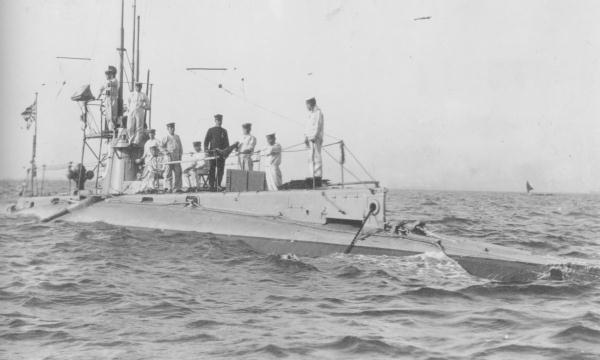
The first of three classes of “Vickers Boats”. These first two experimental boats were based on the mature British “C” class design. They were ordered under the 1904 programme, in 1907 to Vickers Barrow. The Yard completed a specially designed ships to carry them in sercret to Japan. Thrice larger than previous Hollan & Holland-Kaigun boats they were 321 tonnes submerged, and for the first time fitted with a defensive machine-gun. They served for evaluation of overseas operations but failed to reach the demands of the Admiralty on long range. The latter soon turned to Schneider Laubeuf designs and to test also the Italian Fiat-Laurenti double hulled models.
Specifications below are given for all three C types, since they shared the same caracteristics essentially, with some differences as seen in the table below (starred).
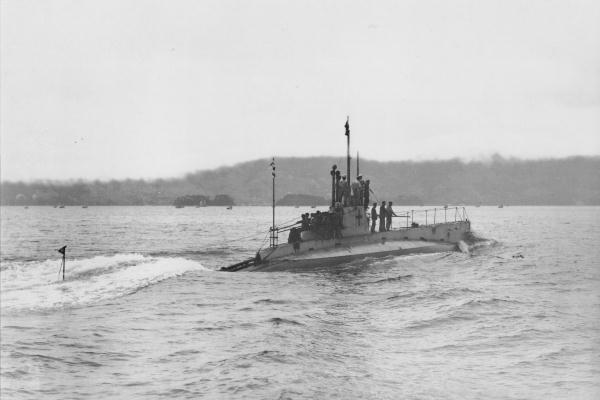
Ha-3, ex N.10, Vickers C2 Type
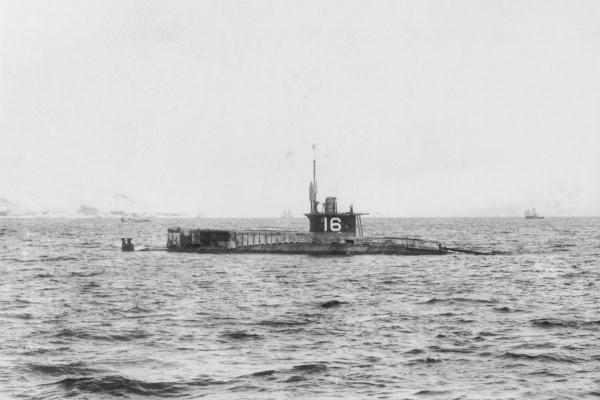
Ha-7, ex. N°16, C3 Type
The two C1 sported their new name Ha-1 and 2 only for four years as they were discarded in 1928.
The C2 were a slightly modified version ordered after the 1910 programme and delivered in section for assembly to Kure, and also dieactivated in 1928.
The C3 were seentially “repeat C1” and were considered obsolete when ordered under the 1915 programme, and entirely built at Kure. Both were stricken in 1928. All these C types served allegedly in the same unit (7 boats in all) without accident to test oceanic tactics. It seems they never operationally left Japanese waters.

C3 Type profile
⚙ specifications C1 Type |
|
| Displacement | 286t/321t (*C2 291t/326t) |
| Dimensions | 142ft 3in oa x 13ft 7in × 11ft 3in (43.3m x 4.1m x 3.4m) |
| Propulsion | 1 shaft 16-cyl Vickers Diesel, electric motor,600bhp/300hp |
| Speed/Range | 12kts/8.5kts. Oil 15t(*15.5t C2) for 660nm/60nm at 12kts/4kts |
| Max depht | 130 ft (est.) |
| Armament | 2-18in (457mm) TT (2 torpedoes), 1 MG |
| Crew | 26 |
 Vickers-Kawasaki Type (1912)
Vickers-Kawasaki Type (1912)
Vickers again, but of the Kawasaki design. The letters meaning “Vickers-Kawasaki”. They were built at the latter yard, based on the early holland type design and under the 1910 programme, but uner supervision by a team from Vickers. This was the “British Holland” design, also for experimental purposes. So only a single boat was made, N°13, renamd Ha 6 in 1924, and BU in 1928. She was launched at Kobe on 18 February 1912 and considered already obsolete, but its goal was to bring design ideas about the British take on the Holland type, already out of favor as in 1918, coastal types were completely abandoned and there was a deep doctrinal change. She was used for training and trials all the way to when she was stricken in home waters.

VK class, N°13 in 1920
⚙ specifications VK |
|
| Displacement | 304t/340t |
| Dimensions | 126ft 9in oa x 12ft 7in × 10ft (38.6m x 3.8m x 3.1m) |
| Propulsion | 1 shaft 16-cyl Gas.+ electric motor, 1000bhp/300hp |
| Speed/Range | 10.8kts/8kts. Oil 17.8t |
| Max depth | Unknown |
| Armament | 2-18in (457mm) TT (2 torpedoes) |
| Crew | 26 |
 Schneider Types S1/S2 (1916-18)
Schneider Types S1/S2 (1916-18)
With this lot, three experimental submersibles, Japan wanted to test the alternative French design, or Schneider-Laubeuf given its reputation of great surface performances, speed and range.
In fact these were the first very long range models ordered by the IJN and they were ordered to Schneider Creusot plant in December 1911, under the 1912 programme. Doubled hulles, they had a far greater oil capacity, but delays saw these started in 1911 and 1915 and requisitions came when the great war broke out: N°14 started in July 1915 became the French Armide when launched in june 1916. N°15, started earlier in March 1911 was however delayed and only launched in July 1917, delivered in 1918. She became Ha 10 in 1924 and was stricken four years aferwards.
To compensate for the absence of delivery for N°14 a second one was ordered in Japan, built in Kure on slightly different specs. It was longer and only had two drop collars whils its Schneider-Carel diesels were imported from France. Specs below are for S1 with S2 starred in brackets. N°14 bis was started in August 1918, launched in March 1920, became Ha 9 in 1924 and was scrapped in December 1928. They were considered slow however and the drop-collar system did not convinced the admiralty.

Profile S1 1919
⚙ specifications S Type |
|
| Displacement | 418t/665t (*480/737t) |
| Dimensions | 186 x 17 x 10ft 2in (*192 x 17 x 10 ft 8in) |
| Propulsion | 2 shaft diesels Schneider, 2 electric motor, 2000bhp/850hp(*1800bhp) |
| Speed/Range | 10kts/4kts. Oil 32t 2050nm/60nm (*oil 35t, same) |
| Max depth | Unknown |
| Armament | 4-18in (457mm) torpedoes in drop collars, 1x 2-pdr(*2 Torps, 7.7mm MG) |
| Crew | 30 |
 F1/F2 class (1919-21)
F1/F2 class (1919-21)
The commission also toured Italy in 1911 and always for the 1912 programmed, visited the FIAT design bureau, and was offered a model designed by Laurenti and stated as truly ocean-going. Plans were acquired for a construction in Japan, and thus, the base model F1 was improved, for a final total of five boats. However compared to IJN standard the elliptic hull was considered weaker than round ones and modifications were done to keep the extra resistance of IJN models.
The two F1 and three F2 were virtually identical but for the wider hull for the F1.
The first serie has its scatntlings revised during construction for extra rigidity, and both N°18 and 21 were built at Kawasaki, Kobe between 1919 and 1920, renamed Ro-1 and 2 in 1924 and discarded in 1930. They had an aft deck 3-in/28 gun, and the serie F2 (N°31, 32, 33 made in 1921-22) had a reworked conning tower. They had both a dual-purpose 3-in/28 and 7.7mm MG. Both had four tubes forward, one aft and 8 reloads. The FIAT diesels were judged unsatisfactory and only procured for F1 13 kts instead of 15 and 14 instead of 17 for the F2. They were also considered unreliable and the whole follow-up serie planned for the 1919 porogramme were cancelled and replaced by K and L boats. They would have been named N°48-50, 60 and 61.
The whole F serie was stricken in 1930.

F1, N°21

F2 N°31
⚙ specifications F1/2 |
|
| Displacement | 689t/1047t |
| Dimensions | 215ft 1in oa x 19ft 11in × 13ft 9in (*13ft 3in) |
| Propulsion | 2 shafts Fiat diesels, 2 Savigliano electric motors, 2800bhp/1200hp |
| Speed/Range | 13kts(*14kts)/8kts. Oil 58.4t Range 3500/75 nm 10/4 kts |
| Max depth | Unknown |
| Armament | 5-18in (457mm) TTs (8 torpedoes), 3-in/28 gun |
| Crew | 43 |
1919-22 Evolution
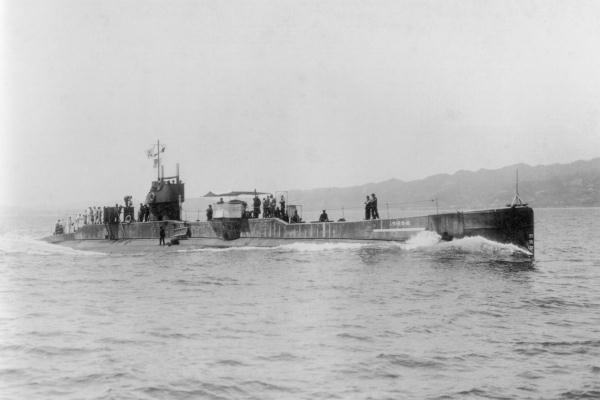
Submarine No. 25 on sea trials off Awaji Island in the Seto Inland Sea in June 1920. She was renamed Ro-51 on 1 November 1924.
As in the case of destroyers, Japanese submarine policy changed radically towards the end of the war. It appears that attention turned from the area immediately around Japan to the East, amid the former German Pacific islands, an area through which the US Fleet would have had to pass en route to any decisive engage ment closer to Japan. Thus, large numbers of medium submarines were cancelled in 1922 in favour of smaller numbers, of much longer range submarine cruisers of the KD and J types. The coincidence in dates suggests that the change in strategy was due to the numerical inferiority in capital ships which Japan had to accept as part of the Washington Treaty. Submarines, like destroyers armed with 24-in torpedoes, became valuable equalisers.
Thus, it was reported 1921 that future Japanese policy would be to build only two types:
-Very large ocean-going cruisers (some minelayers)
-Smaller ocean boats of up to 1000 tons and moderate speed, (also some of which would be minelayers).
-Construction of 500t coastal boats would be abandoned.
In effect, the definition of coastal vs oceanic types changed. In 1921n the existing ‘K’ and ‘L’ boats were considered good for 5,000 to 6,000nm, which in other navies might be considered ocean range. Now the requirement rose to 10,000 to 20,000 nm, as the expected operational area moved well to the East.
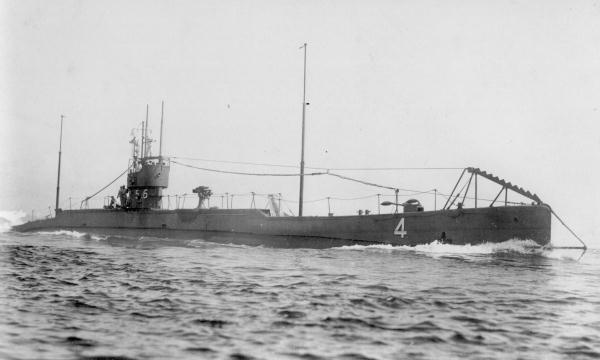
Ro 56 circa 1925
Even before this shift the Japanese Navy emphasised long endurance, which was partly a function of the ability of crews to adapt to cramped conditions. It was reported in 1919 that No 16, a small coastal boat, made a three week cruise, only touching at three ports for a few hours during that period. During World War One, crews of Western ocean submarines found a three week cruise the limit of their endurance. That must have been partly a function of the strain of constant danger in a war zone, but a British observer, Hector Bywater (who published Sea Power in the Pacific in 1921) , concluded that, given two submarines of identical type, tonnage, and fuel capacity, one manned by a Japanese crew and the other by a Western crew, the boat with the Japanese complement could stay at sea 30% longer.
 L class (1919-21)
L class (1919-21)
L 1 class submarines
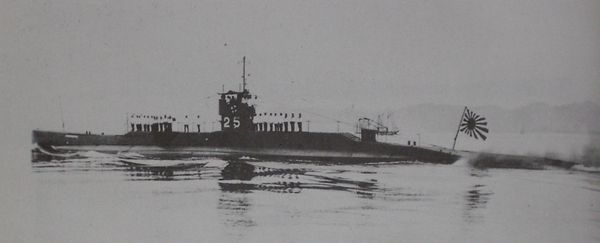
Ro 51 of L 1 type in the 1920s
This Mitsubishi-Vickers type was similar to the early British ‘L’ class of 1916, the standard British ‘overseas’ patrol submarine of its period, and thus the lineal successor to the earlier ‘C’ class. It was a single-hull submarine with saddle tanks, like the earlier ‘C’, and unlike the Schneider type. The Japanese Navy contracted with Vickers late in 1917 , ordering the first unit from Mitsubishi (Kobe) in March 1918. Diesel engines were imported from England or built in Japan. No 26 sank on 29 October 1923 at Kure due to a flooding error but was raised on 17 November. In all, nine were built on slightly diverged specs, two of the first, four of the second and two on the last (L3). Construction: No 25 (10.10.19, 30.6.20, Ro 51 1924, stricken 1940), No 26 (9.3.20, 30.11.20, Ro 4 1924, stricken 1930).

N°25, L1 Type
⚙ specifications L1 |
|
| Displacement | 893t/1195t |
| Dimensions | 231ft 7in oa , 220ft 3in pp x 23ft 6in × 12ft 11in 70.6m (67.1m x 7.2m x 3.9m) |
| Propulsion | 2 shafts 4-cyl Vickers diesels, 2 electric motors, 2400bhp/1600hp |
| Speed/Range | 17/8kts. Oil 75t Range 5500/80 nm |
| Max depth | Unknown |
| Armament | 6-18in (4 bow, 2 beam) TTs (10 torpedoes), 3-in/28 gun, 7.7 mm MG |
| Crew | 48 |
L 2 class submarines
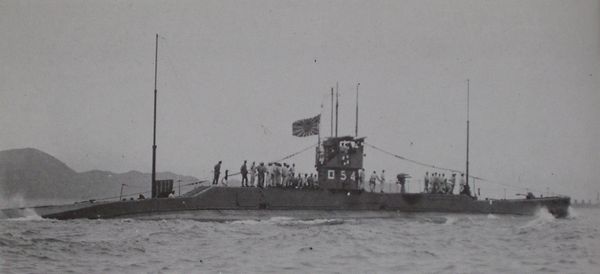
Ro 54 of L 2 type in the 1920s
They were a slightly modified L type also built by Mitsubishi, Kobe under the the 1918 Programme. The principal difference was omission of the two beam TT and 5t more oil fuel.
Particulars as L 1 class.
construction: No 27 (6.7.20, 10.3.21, Ro 53 1924, stricken 1938), No 28 (13.10.20, 10.9.21, Ro 54 1924, stricken 1939), No 29 (10.2.21, 15.11.21, sunk 29.10.23 in accident off Kobe, raised to be Ro 55 1924, stricken 1939), No 30 (11.5.21, 16.1.22, Ro 56 1924, stricken 1940).
L 3 class submarines
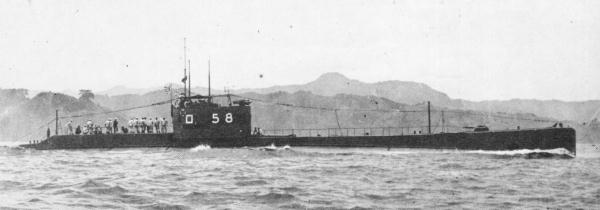
Ro 68 of L 3 Type in 1925
These submarines were similar to the L 2 type but had 21-in TT tubes, and carried their 3.1 in guns atop their fairwaters instead of on deck forward of them. A minelaying version, similar to British mining submarines, with mines carried in tubes in the saddle tanks, was planned in 1921 but not built, as L(M) Type. Oil tankage was later increased to 117t. All 3 still existed in 1941 as training boats. No 46 was used to train midget submarine crews at Shodojima in 1945 and No 57 likewise at the Submarine School, Otake.
Diesign differences specs: Displacement 897t/1195t, dimensions 250ft oa , 242ft 9in x 23ft 6in × 13ft 76.2m , 74m x 7.2m x 4.0m. Machinery same except 98t oil tanks capacity for a range of 7000nm/85nm at 10kts/4kts.
Construction: No 46 (3.12.21, 30.7.22, Ro 57 1924, stricken 1.5.45, BU 1946), No 47 (2.3.22, 25.11.22, Ro 58 1924, stricken 1.5.45, BU 1946), No 57 (28.6.22, 20.3.23, Ro 59 1924, stricken 1.5.45, BU), Nos 48-50 cancelled in 1920 and replaced by minelayers of the KRS type.
 K class (1917-21)
K class (1917-21)
16 submarines: K1(2), K2(3), K3(10), K4(3)
K1 class:
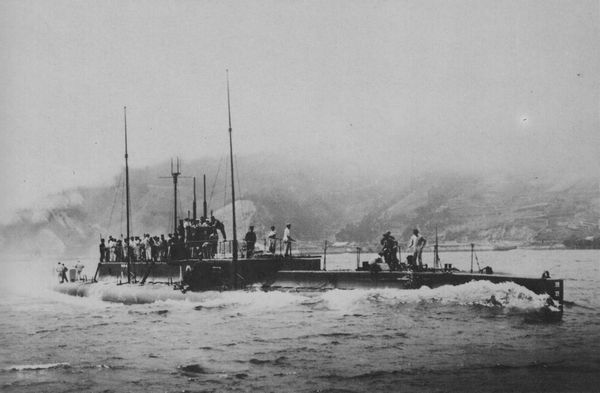
Ro 11 of the Kaichu I type in 1919, in sea trials.
The “Kaichū type” were named after the design yard, Kawasaki, Kobe. In all, 16 boats were built in four successive variant, and a single one destined to form the first large operational submarine squadrons in the IJN, the K3. They were based on the S type (Schneider Laubeuf type) aimed at longer range and better surface speed.
Class: No 19 (Kure N Yd, launched 15.10.17, comp. 31.7.19, Ro 11 1924, stricken 1931), No 20 (Kure N Yd, launched 1.12.17, Ro 12 1924, stricken 1931)
This S7 or Kaigun (Navy) medium design, derived from the Schneider Laubeuf type, was the first fully Japanese boat, the various foreign designs having been found deficient in hull strength. Work on this class, specially adapted to Far Eastern rather than to European conditions, began in 1916. The principal difference was that Japanese and Pacific waters were much deeper than the North Sea and the Mediterranean, so that submarines could not expect to lie on the bottom very often. Thus reliable depth control was extremely important.
Moreover, powerful and erratic sub surface currents tend to drive submarines off their course and produce sudden changes of trim, hence involutary dives below operating depth. Thus the emphasis on hull strength. In 1921, it was claimed that the ‘K’ class with their beamy but enormously strong hull, were therefore more capable of resisting depth charge attacks than any other type. These boats were said to have been dived to depths at which European submarines would collapse (so below 220 m) or have survived groundings, collisions and other accidents that would have been fatal to foreign boats. For example, Nos 19 and 20, the first of the Kaigun type rammed one another in the 1919 manoeuvres. Although seriously damaged, both returned to port safely and were repaired. Besides being exceptionally strong in framing and plating, the Kaigun boats were said to have an abnormal amount of internal subdivision and bulkheading. This rendered them very cramped and uncomfortable internally. The Sulzer diesels were Swiss-built. All French submersibles of the interwar and those exported used them as alternative to MAN diesels.

K1 Profile
⚙ specifications K1 |
|
| Displacement | 735t/1030t |
| Dimensions | 227ft oa x 20ft 10in × 11ft 3in (69.2m x 6.4m x 3.4m) |
| Propulsion | 2 shafts Sulzer diesels, 2 electric motors 2600bhp/1200hp |
| Speed/Range | 18kts/9kts, Oil 60t. Range 4000nm/85nm 10/4kts |
| Max depth | Unknown |
| Armament | 6-18in (457mm) TT, 2 drop collars, 10 reloads. 1x 3-in/28 gun |
| Crew | 44 |
K2 class:
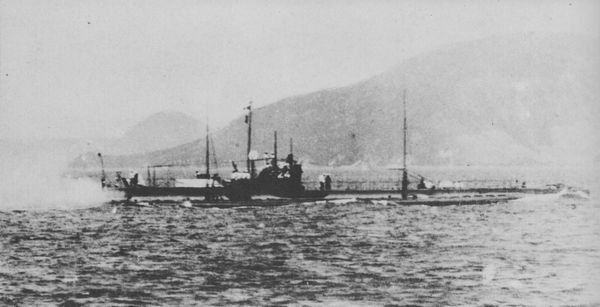
Ro 15 of the Kaichu II type
Kaigun type Type S18 built by Kure (3 boats) on a modified design, same powerplant and lower speed. The bow, fairwater and stern were shaped differently and the latter was overhanging. The class comprised N°22 laid down in March 1919, N°23 in August 1919, N°24 October 1920, launched 1920-21, completed in 1921. Renamed Ro 14, 13 and 11 respectively, stricken 1948, 32 and 1931. Displacement 755/1050 tonnes, 230 x 20 x 12 ft, 17 kts surfaced and 75 tons oil, range 6000 nm/40 kts.

K2 Type, N°22 in 1921
K3 class:
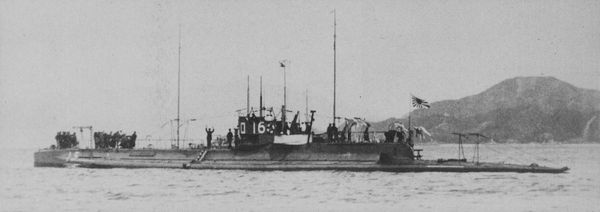
Ro 16 of the Kaichu III in the 1920s
Specs as K2. First serie of 9 built, through three yards.
A slightly improved version of the 1917 K 2 class, but designed by Kure N Yd under the 1918 Programme. Up to this time this was the most numerous single class (9 boats), marking the development of what must have appeared to be a satisfactory design. Nos 38 and 39 were sold to Kanagawa Prefecture in 1932 for 5000 yen each and scuttled to act as breeding grounds for fish. No 43 sank on 19 March 1924 in collision with the light cruiser Tatsuta off Sasebo, was raised on 25 April and used for trials.
A slightly improved under the 1918 Program class (9 boats), marking an overall satisfactory design.
Kure Nyd: N°34 (24.2.21, 20.10.21, R 17 1924, stricken 1.4.1932), No 35 (25.3.21, 15.12.21, Ro 18 1.11.24, stricken 1.4.36), No 36 (28.12.20, 15.3.22, Ro 19 1.11.24, stricken 1.4.36, BU 1948 at Naniwa); No 37 (22.4.21, 29.4.22, Ro 16 1.11.24, stricken 1.4.36)
Yokosuka N Yd: No 38 (26.10.20, 1.2.22, Ro 20 1.11.24, stricken 1.4.32 and sold), No 39 (26.10.20, 1.2.22, Ro 21 1.11.24, stricken 1.4.32 and sold), No 40 (15.10.21, 10.10.22, Ro 22 1.11.24, stricken 1.4.32), No 41 (25.10.21, 28.4.23, Ro 23 1.11.24, stricken 1.4.32)
Sasebo N Yd: No 42 ( 8.12.19 , 30.11.20 , Ro 24 1.11.24 , stricken 1.4.32 ) , No 43 ( 17.7.20 , 25.10.21 , Ro 25 1.11.24 , stricken 1.4.36 and BU )
K4 class (1921):

RO 26 in 1923
The Kaichū IV was also called Ro-26 class (Ro 26, 27 and 28, S18A design) very close to the earlier boats. Compared to K2 they were 4m longer, with K1 propulsion but new 21-in (533 mm) torpedo tubes. Many more were cancelled, N°48-50, 74-83, 85-87 as in 1922 the doctrine changed. The three were built at Sasebo NyD (26, 28) and Yokosuka (27), laid down in 1921, completed in 1923-24, renamed No. 45, 58 and 62. N°58 became Ro-27, in service until 1936 but not scrapped until 1948, and used in harbour duties. The two others, Ro-28 and Ro-27 were discarded in 1940, but scrapped in 1948.
This Design S18A was slightly larger than K3, with 21in rather than 18in TT, and the 3.lin gun forward of the fairwater instead of abaft it. Nos 44 and 51 reordered to new (large) designs. Note that a K5 design (Ro 33-34 of 1933) was not related to this one: It was a mobilisation design for a medium submarine. Ro 26 refitted 1932, Ro 27 and Ro 28 in 1934.
Cancellations (1922): Nos 48-50 were reordered as minelayers (KRS) in May 1923; Nos 53-56, 60-61, 63-67 were cancelled. Of the last group, all but No 67 had been ordered.
In addition, Nos 74-83, 85-87, which would have been of ‘K’ and ‘L’ types, were cancelled. The 8-8 plan envisaged another 28 subinarines (Nos 88-116), but plans were redrafted following the Washington Conference.
Class: No 45 (Sasebo N Yd, 18.10.21, 25.1.23, Ro 26 1.11.24, stricken 1.4.40 and BU 4.48 at Kanagawa), No 58 (Yokosuka N Yd, 22.7.22, 13.7.24, Ro 27 1.11.24, stricken, 1.1.40 and BU 10.47 at Iwakuni), No 62 (Sasebo N Yd, 13.4.22, 30.11.23, Ro 28 1.11.24 and BU 5.48 at Kumagaya Gumi)
Specifications: Displacement 770 t. surface 1080 t. sub., Dimensions 74.20 m long, 6.10 m wide, 3.7 m draft. Machinery 2 shafts MAN Sulzer diesels and electric motors, 2600/1200 bhp.
Top speed 19 knots surface/9 knots submerged, Armament 1 x 3.1 in/28 AA (80 mm), 1 x 7.7 mm MG, 4 TT 533 mm, Crew 45.
 KT class (1922)
KT class (1922)
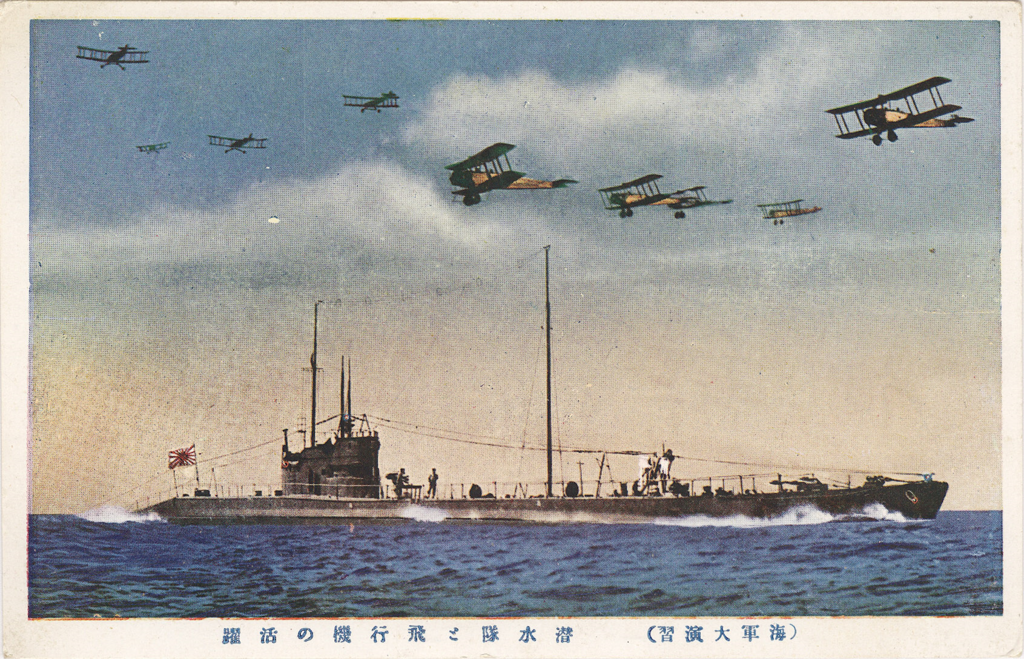
Ro 29 (ex N°68) in 1930, with a flight of Mitsubishi 2MR4 recce naval airplanes overhead.
These boats were built under the project number S18B for the commerce raiding role. Built at the Kawasaki-Kōbe Shipyard, with the IJN official designation being “Special Purpose-Medium Type submarine” (“Toku-Chū-gata sensuikan”) ordered in June and September 1921.
The Kaichu V sub-class were designed for anti-shipping operations, with more fuel, greater range, heavier gun armament and a deisplacement of 866 tonnes (852 long tons) surfaced, 1,036 tonnes (1,020 long tons) submerged.
For surface running they had two Sulzer diesel engines and in complement powerful electric motor for 13 knots (24 km/h; 15 mph) surfaced, 8.5 knots (15.7 km/h; 9.8 mph) submerged, 9,000 nautical miles (17,000 km; 10,000 mi) but 6,000 announced officially. Submerged, this still was 85 nmi (157 km; 98 mi) at 4 knots.
In total they had four internal bow 533 mm (21 in) torpedo tube with one reload for each tube. Their single 120 mm (4.7 in) deck gun was a serious proposition, and this was completed by the usual 6.5 mm AA machine gun. In WW2 they were retained for training only.
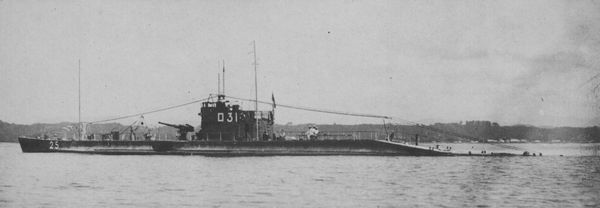
Ro 31 in 1935
No.68 (Ro-29 05-12-1922 15-09-1923, Ro-29 1924. Decommissioned 01-04-1936), No. 69 (18-01-1923, 29-04-1924, Ro-30 1924. Decommissioned 01-04-1942, Scrapped 1945) No.70 (15-02-1923, Lost in an accident off Awaji Island 21-08-1923, salvaged and scrapped October 1923, hull and parts reused for Ro-31), Ro-31 (Order 20-12-1924, launched 25-09-1926, comp. 10-05-1927, Decommissioned 25-05-1945 and scuttled off Sasebo 05-04-1946), No.71, renamed Ro-32 (started 19-03-1923, launched 21-05-1924. Decommissioned 01-04-1942. Scrapped 1945).

N°68, KT classs (Kaishu V) in 1926
⚙ specifications KT |
|
| Displacement | 866/1,036 tonnes. |
| Dimensions | 243 ft 6 in x 20 ft 1 in x 12 ft 3 in (74.22 x 6.12 x 3.73 m) |
| Propulsion | 2 shafts Sulzer diesels, 2 electric motors 1200bhp/1200hp |
| Speed/Range | 13kts/8.5kts, Range 9000nm/85nm 10/4kts |
| Max depth | 150 ft (45.7m) |
| Armament | 4x 21-in (533mm) TTs, 8 reloads. 1x 5-in gun, 6.5 mm MG AA |
| Crew | 55 |
Design of WW1 IJN submarines
Hull Types and engines
Armament
Guns
Armament
Guns
Guns
The very first Holland type, like the original, had no deck gun, this was introduced on the S class, with a single Maxim 2-pdr (40 mm) AA deck gun. It was replaced by a 7.7mm AA MG.
The L class introduced a new dual purpose 3.1-in/28 gun forward complemented by a 7.7mm MG in the CT, but this was for close defence. The K class were also armed the same.
Deck guns as an offensive asset were only seriously considered after WWI, for the last Kaichu V sub-type (KT class).
For the first time they were given a 120 mm (4.7 inches)/45 deck gun forward. These were clearly intended as an offensive complement to the torpedoes.
This became the new standard on interwar IJN submarines.
Torpedoes
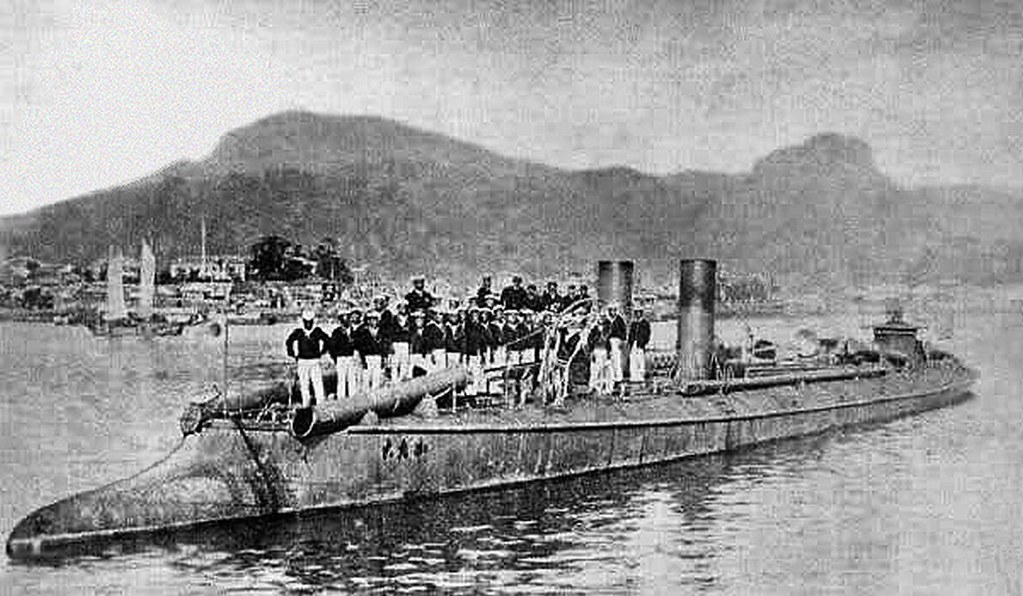
Experience with torpedoes in the IJN started with Kotaka, first Japanese torpedo boat, British-built in 1887. She had no less than six 360 mm (14 in) torpedo tubes.
Naturally when swapping on a first submersible of the Holland type, US modified design, a US pattern single tube was adopted.
The first model adopted was the standard international 18 inches or 457 mm. Bring British/US designs, they adopted Whitehead Type 32 torpedoes built in Japan at Kure arsenal.
These could have been the 18″ (45 cm) Type 37 (1904), 38 N°1 or 2 and 2B.
Specs (2B): Weight 1,354 lbs. (614 kg), 200 in (5.09 m) long, 209 lbs. (95 kg) Picric Acid or Shimose warhead, 1,100 yards (1,000 m)/40 knots or 4,400 yards (4,000 m)/23 knots settings, powered by
Compressed air.
The first to introduced 21-in torpedoes were the Kaichu IV type (launched 1923): They had four in the bow. The Kaichu V or KT had the same.
These models are better known, applied to all “Ro” type submarines:
Designed in 1917, in service by 1918, they had the following specs:
Weight: 3,157 lbs. (1,432 kg)
Overall Length: 269 in (6.84 m)
Explosive Charge: 448 lbs. (203 kg) Shimose
Settings: 7,650 yds/35 kts or 10,900/32 kts or 16,400/26 kts
They were powered by a Kerosene-air wet-heater.
WW1 IJN submarines in action (Both wars)
WW1 to Interwar
From before WWI as the concept matured, the IJN considered at first small boats for limited oceanic patrols, off Japanese waters, after some service in the Pacific, notably around recently acquired islands, or the coast of China and China and Yellow seas in general. The usual service routine was spent between squadron and fleet exercizes, patrols cut by intermittent dive exercizes, fring tests at the range and on various targets. Due to the commitment of Japan to the side of the entente nations in WWI, it was intended to send some long-range models to the German-held islands, to take position and prevent any escape towards the Indian Ocean or Panama Canal.
War Prizes and influence on IJN design
Japan for her participation in WWI to the side of the entente won territories and experience but also obtained the following:
Mittel-U types: U-55 and U-46 as O1 and O2. They constituted the medium-light WW1 German submarines.
UB types: UB-III class UB-125 and UB-143, precursors of the ww2 type VII U-Boat. Oceanic types, range patrols. They were called O6 and O7.
UE type: Minelayer submarine U-125, in service as O1, later inspiring the KRS class of 1926.
UC III type: UC-90 and 99, in service as O4 and O5 respectively, helping to refine the oceanic type.
U-Kreuzers: No full boats but plans, which inspired KD2 class, starting with the Junsen or J1, modelled after U-142. 1922-23 program subs were designed and built under supervision of engineer Dr. Ing. H Techel, invited in Japan from the Krupp Germania yard and using German MAN diesels.
The KT class in WW2
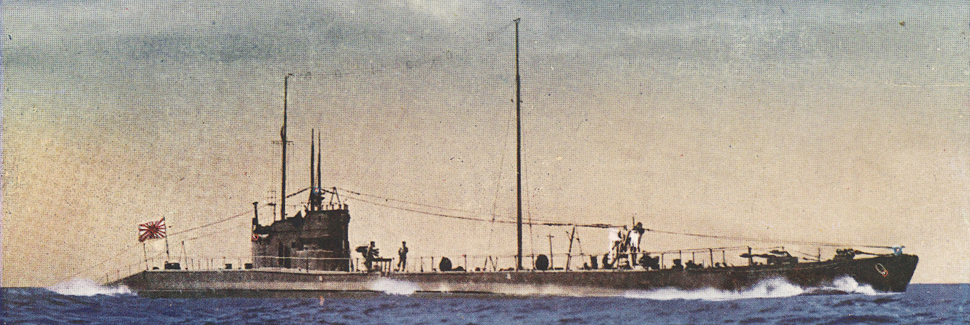
The KT class (Or Kaichu V type) are the last submersibles treated here, and the only ones that saw action in WW2 due to their late completion: Only four of the 665 tons boats (surfaced), considered as medium coastal, launched in 1922 were completed in 1923-24 and thus missed any action for the first war, but they had extensively well trained crews when Japan attacked China in 1937. Of the Schneider Laubeuf Type, they had good surface performances. The obtention of German U-Boats which followed the same trend (they were initially started with Laubeuf types) confirmed the type was preferred over the older Holland-derivative Vickers/Mitsubishi designs. The “K” stands for Kobe, where they were constructed.
So previousy Called ‘S’ types, N°68 to 71 were later renamed at completion in 1924 as Ro-29 to 32. Only two in the end saw service along the Chinese coast and in the confines of Japanese waters for training: Inded, Ro 29 was discarded already in 1936. The other three served in 1941 as well but Ro 32 became in March 1942 a training hulk as Ro 30 at Otake. It seems only Ro 31 (which sunk on trials in 1924 but was refloated and repaired) saw no more “active service” in WW2, as like the other she was used as a training submarine due to her age: Recommissioned on 9 February 1942 to serve as a training submarine, she was initially attached to the Kure Naval District, then to the Yokosuka Naval District, from 14 July 1942 to 15 January 1943, and Kure Naval District until 15 January 1944. Decommissioned again, she was placed in the Fourth Reserve, Kure Naval District. Stricken on 25 May 1945, it seems she only had a skeleton maintenance crew and she was was the only one to be scuttled in 1946 by the USN after surrendering to the allies. Ro 30 and Ro 32 were stricken and BU after August 1945.
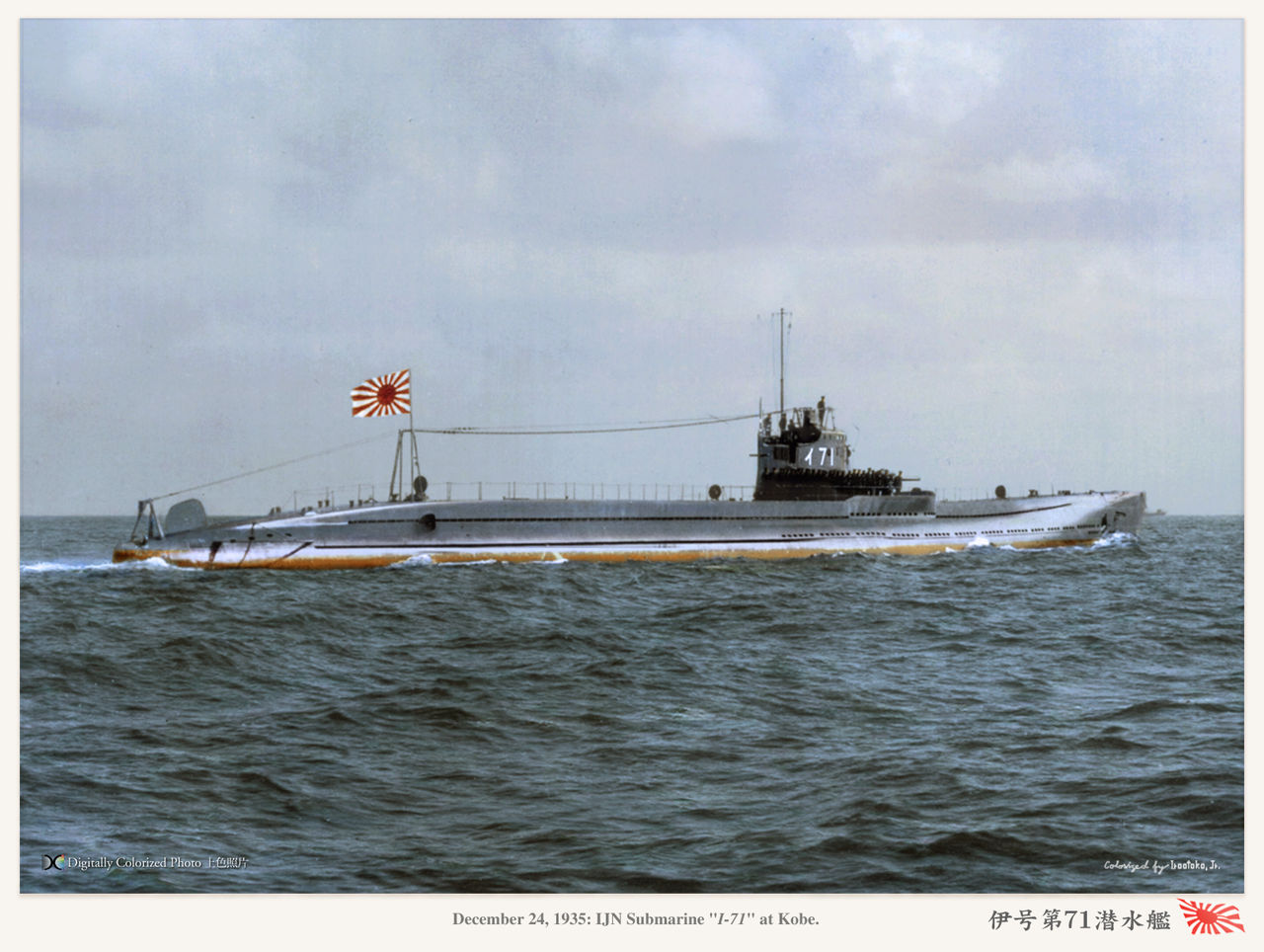
Kaichu Type, a direct successor of the Kai-toku-chu (KT). They were numbered “RO” and built from 1935 to 1944 constructed at four shipyards (K.5 or RO-33 class and K.6 or RO-35 class) as medium double-huller submarines.
Read more
Books
Submarines of the Imperial Japanese Navy Hardcover 1986 by Dorr Carpenter, Norman Polmar
Conways all the world’s fighting ships 1906-1921 and 1922-47
The Japanese Submarine Force and World War II (Bluejacket Books) Carl Boyd, Akihiko Yoshida
Osprey New Vanguard IJN Submarines 1941-45 Mark Stille, Tony Bryan
Sunk: The Story of the Japanese Submarine Fleet, 1941-1945
USN Fleet Destroyer Vs IJN Fleet Submarine Pacific 1941–42 by Mark Still & Mochitsura Hashimoto
Links
Type L submarines
thediplomat.com/ imperial-japans-naval-contributions-to-the-first-world-war/
navweaps.com Pre-WWII IJN torps
Submarines_of_the_Imperial_Japanese_Navy
combinedfleet.com ss. tyeps
//www.combinedfleet.com/sensuikan.htm
on militaryfactory.com ww2-japanese-submarines
on ibiblio.org
combinedfleet.com torpedoes
Type 1 submarines
Type 6 submarines
Ha-1 class submarines
Kaichu type submarine
3D:
None found
Model’s corner:
None found

 Latest Facebook Entry -
Latest Facebook Entry -  X(Tweeter) Naval Encyclopedia's deck archive
X(Tweeter) Naval Encyclopedia's deck archive Instagram (@navalencyc)
Instagram (@navalencyc)





 French Navy
French Navy Royal Navy
Royal Navy Russian Navy
Russian Navy Armada Espanola
Armada Espanola Austrian Navy
Austrian Navy K.u.K. Kriegsmarine
K.u.K. Kriegsmarine Dansk Marine
Dansk Marine Nautiko Hellenon
Nautiko Hellenon Koninklije Marine 1870
Koninklije Marine 1870 Marinha do Brasil
Marinha do Brasil Osmanlı Donanması
Osmanlı Donanması Marina Do Peru
Marina Do Peru Marinha do Portugal
Marinha do Portugal Regia Marina 1870
Regia Marina 1870 Nihhon Kaigun 1870
Nihhon Kaigun 1870 Preußische Marine 1870
Preußische Marine 1870 Russkiy Flot 1870
Russkiy Flot 1870 Svenska marinen
Svenska marinen Søværnet
Søværnet Union Navy
Union Navy Confederate Navy
Confederate Navy Armada de Argentina
Armada de Argentina Imperial Chinese Navy
Imperial Chinese Navy Marinha do Portugal
Marinha do Portugal Mexico
Mexico Kaiserliche Marine
Kaiserliche Marine 1898 US Navy
1898 US Navy Sovietskiy Flot
Sovietskiy Flot Royal Canadian Navy
Royal Canadian Navy Royal Australian Navy
Royal Australian Navy RNZN Fleet
RNZN Fleet Chinese Navy 1937
Chinese Navy 1937 Kriegsmarine
Kriegsmarine Chilean Navy
Chilean Navy Danish Navy
Danish Navy Finnish Navy
Finnish Navy Hellenic Navy
Hellenic Navy Polish Navy
Polish Navy Romanian Navy
Romanian Navy Turkish Navy
Turkish Navy Royal Yugoslav Navy
Royal Yugoslav Navy Royal Thai Navy
Royal Thai Navy Minor Navies
Minor Navies Albania
Albania Austria
Austria Belgium
Belgium Columbia
Columbia Costa Rica
Costa Rica Cuba
Cuba Czechoslovakia
Czechoslovakia Dominican Republic
Dominican Republic Haiti
Haiti Hungary
Hungary Honduras
Honduras Estonia
Estonia Iceland
Iceland Eire
Eire Equador
Equador Iran
Iran Iraq
Iraq Latvia
Latvia Liberia
Liberia Lithuania
Lithuania Mandchukuo
Mandchukuo Morocco
Morocco Nicaragua
Nicaragua Persia
Persia San Salvador
San Salvador Sarawak
Sarawak Uruguay
Uruguay Venezuela
Venezuela Zanzibar
Zanzibar Warsaw Pact Navies
Warsaw Pact Navies Bulgaria
Bulgaria Hungary
Hungary

 Bundesmarine
Bundesmarine Dutch Navy
Dutch Navy Hellenic Navy
Hellenic Navy Marina Militare
Marina Militare Yugoslav Navy
Yugoslav Navy Chinese Navy
Chinese Navy Indian Navy
Indian Navy Indonesian Navy
Indonesian Navy JMSDF
JMSDF North Korean Navy
North Korean Navy Pakistani Navy
Pakistani Navy Philippines Navy
Philippines Navy ROKN
ROKN Rep. of Singapore Navy
Rep. of Singapore Navy Taiwanese Navy
Taiwanese Navy IDF Navy
IDF Navy Saudi Navy
Saudi Navy Royal New Zealand Navy
Royal New Zealand Navy Egyptian Navy
Egyptian Navy South African Navy
South African Navy






























 Ukrainian Navy
Ukrainian Navy dbodesign
dbodesign